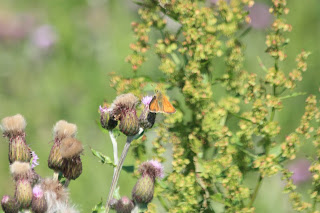We try to walk the beautiful four and a half mile walk though the Dameny Estate from Cramond Brig to South Queensferry once every summer. It's a lovely scenic area, incorporating woodland
coastal views over the Firth of Forth
and farmland, with lovely flower rich field edges
Yesterday was hot and sunny but breezy, which felt like the ideal weather for this four and a half mile walk. It was very warm in the open but the frequent patches of woodland offer cooling shade. We hoped that this would be ideal weather to bring out the butterflies. We have often seen good numbers of butterflies here and although this year's Spring was very poor for these insects, we have seen very good numbers of butterflies in recent weeks including at Arthur's Seat, Lauriston Farm fields and Musselburgh Lagoons. So we hoped yesterday to see good numbers to record for the Big Butterfly Count. Sadly we were disappointed to see only a relatively small number of butterflies, including one green veined white, a couple of other whites and a handful of speckled woods.
Nevertheless, we still had a good walk, enjoying the magnificent Scots pines that thrive in the woodland (I'd never before noticed just how many of these trees there are here!)
It seems a shame though that one lovely area currently covered in wildflowers, has recently been planted with young trees
Of course trees are good and these newly planted saplings seem all to be native species (Scots pine and birch as far as I could see) but wildflower meadows are good too, a beautiful sight and also excellent food sources for insects including bees, hoverflies and butterflies. It's really nice to see a wildflower meadow alongside a wooded area and it will be sad to see this disappear.
The bright sunshine made for some lovely shadows, like these thrown by bracken
We also noticed that a lot of leaves on many of the trees had been eaten away by insects. Hopefully insects that are providing food for the birds, rather than insect pests carrying disease. Either way, the patterns they make in the leaves are quite beautiful
We came across a large number of feathers scattered over the grass at one point. Perhaps the remains of a predation event, some bird having been killed by a bird of prey or fox. I'm not sure which species of bird these feathers came from, they're very pretty though. Edited to add: Looking at the amazing database that is Featherbase, I think these may be curlew feathers.
On the outskirts of South Queensferry we saw an adult oystercatcher with it's young, which was very cute! Crafty Green Boyfriend took some photos, but I don't know where they are to upload them here (we're currently using a temporary computer set up as our own computer is ill at the moment). I'll hopefully find them and share them in the next few days!
For Nature Notes.

























































